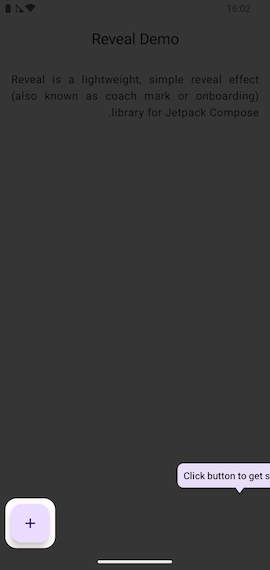Reveal effect (also known as coach mark, onboarding, tutorial, walkthrough, etc.) with a beautiful API for Compose Multiplatform targeting Android, iOS, Desktop and Web.
| Term | Description |
|---|---|
| Revealable | An element which is revealed on the screen. |
| Reveal area | The area which is revealed around the revealable. Usually with a slight padding. |
| Overlay | The overlay which greys out all contents except revealable. Can contain explanatory items. |
As of version 3.0 Reveal is based on Compose Multiplatform targeting Android, iOS, Desktop and
Web. However please not that except Android the other platforms are currently not well tested and
some of the targets are still alpha or experimental.
When using Reveal on Android, please make sure that the version of Google's Jetpack Compose is compatible with the version of Compose Multiplatform that Reveal uses, which you can find here.
The minimum supported Android SDK is 21 (Android 5.0), which is a requirement of Jetpack Compose. Add Reveal as a dependency to your project. It's available on Maven Central.
dependencies {
implementation("com.svenjacobs.reveal:reveal-core:$REVEAL_VERSION")
}| Name | Description |
|---|---|
reveal-core |
Contains core classes. You need this 🙂 |
reveal-shapes |
Additional shapes for explanatory items |
reveal-compat-android |
Compatibility utilities for Android targets with a mixed View/Compose setup |
There are two significant composables:
First there is RevealCanvas, which is responsible for rendering the effect. There should only be
one RevealCanvas instance in the Compose hierarchy and it should be at a top or the topmost
position of the tree in order to ensure that the effect is rendered "full screen" above all other
elements.
Second the Reveal composable is responsible for registration of and interaction with revealable
items. There can be many Reveal instance and they have a direct relation to the RevealCanvas
instance. Usually there should be at most one Reveal per "screen" of an application.
@Composable
fun App() {
val revealCanvasState = rememberRevealCanvasState()
// Single instance that should be at the top of the Compose hierarchy
RevealCanvas(
modifier = Modifier.fillMaxSize(),
revealCanvasState = revealCanvasState,
) {
MainScreen(revealCanvasState = revealCanvasState)
}
}
@Composable
fun MainScreen(revealCanvasState: RevealCanvasState) {
val revealState = rememberRevealState()
// Usually one instance per screen
Reveal(
revealCanvasState = revealCanvasState,
revealState = revealState,
onRevealableClick = {},
onOverlayClick = {},
) {
// Contents
}
}Inside Reveal specify revealable items via the revealable modifier.
enum class Keys { HelloWorld }
Column {
Text(
modifier = Modifier.revealable(key = Keys.HelloWorld),
text = "Hello world",
)
}Now launch the reveal effect via revealState.reveal(Keys.HelloWorld).
Nice, you just launched your first reveal effect. But what is missing is some explanatory item like text or image next to the reveal area. So let's add one.
Explanatory items are specified via overlayContent of the Reveal composable.
Reveal(
overlayContent = { key ->
when (key) {
Keys.HelloWorld -> {
Surface(
modifier = Modifier
.align(horizontalArrangement = RevealOverlayArrangement.Horizontal.Start)
.padding(8.dp),
shape = RoundedCornerShape(4.dp),
color = Color.White,
) {
Text("This is an explanation")
}
}
}
}
) {
// Contents
}The scope of the overlay content composable provides align() modifiers to align the item either to
the start, top, end or bottom of the reveal area.
Reveal provides two click listeners: onRevealableClick is called when the reveal area is clicked
with the key of the current revealable as the first argument. onOverlayClick is called when the
overlay is clicked somewhere, also with the key argument. Use any of these click listeners to reveal
the next item, for example for some kind of tutorial, or to hide the effect via
revealState.hide().
That's it for now. For more details have a look at the demo application and the JavaDoc. The library is well documented 😉
See FAQ.md













